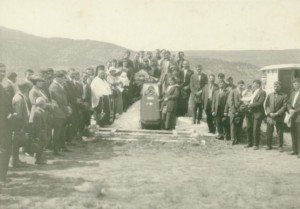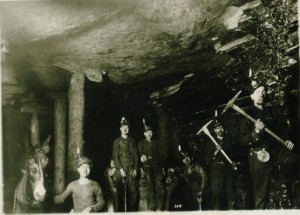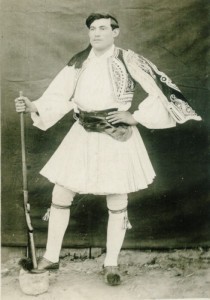In the late 1800s and early 1900s, coal miners used candles to make their way deep underground through the mines, a dangerous practice because of the highly explosive nature of coal dust.
The 1929 funeral of Chris Melonakis’ grandfather, who died from an infection 10 days after unsanitary dental work. He worked in the mine until the day before he died.
The strike eventually blew up into one of the the most violent times in labor history. In 1914, women and children suffocated when company-backed militiamen burned the union tent camp at Ludlow, Colorado. The Ludlow Massacre ignited 10 days of violence known as the Colorado Coal Field War.
Hundreds of thousands of Greeks immigrated to the U.S. in the early 1900s. For many the only work they could get was in the dangerous coal mines around the West. Most of the Greeks in southern Colorado were working in coal mines owned by the huge Colorado Fuel and Iron company, known as CF&I. The mines were notoriously dangerous and the miners lived in extreme poverty.
Greek miners have been called the bone and sinew of the strike, and freedom fighters. Their story is the focus of a new documentary: “Ludlow, Greek Americans During The Colorado Coal War.” The film screens at the University of Colorado in Boulder on Tuesday, Sept. 20.
Frosso Tsouka of Athens, Greece is one of the filmmakers and retired Colorado district judge Chris Melonakis of Westminster is a descendant of Greek miners. They spoke with Colorado Matters host Nathan Heffel.
In 1910, the year Louis Tikas filed his citizenship papers, he was part owner of a Greek coffee house on Market Street in Denver. By the end of 1912 he was an organizer for the United Mine Workers of America. In between he worked as a miner-strikebreaker in Colorado’s Northern (Coal) Field but ended up leading a walkout by sixty-three fellow Greeks at the Frederick, Colorado mine. It was a short journey in time, but a long leap across the ages.
(Trailer for “Ludlow: Greek Americans in the Colorado Coal War.”)
“So Tikas enters his destiny,” wrote Zeese Papanikolas:
It is a moment worth considering. In making the turn from scab to striker he was following the path of thousands of immigrants before him, of whole nationalities. In a profound way, more than at that moment when he set foot on Ellis Island, more than at that other moment when he signed his first papers with a new name, walking out of the Frederick stockade was the most American thing he had done. The revolt of the Greeks in the Utah Copper Company mines [led by the Western Federation of Miners in September 1912] was prophetic. For when the Greeks at Bingham, Utah, rose up against [the padrone] Leonidas Skliris, without knowing it they were rising up against a whole ethos, that ignorance, that poverty in their past which had created such men as Skliris and which, in this New World so desperately needed them. The Bingham strike had not made union men of the Greeks. It was for Tikas and the immigrant organizers like him to take such unformed revolts one step further; to make of the anarchy of the industrial world a map (Papanikolas, Page 49. Emphasis added).
In 1912 there had been much recent history in the ongoing struggles to construct such a map; a mighty conflict was still being waged against the power of monopoly capital by the American people. Politically, that war had manifested itself in the Populist movement; the Grange movement and the farmers’ revolt; the 1896 candidacy of William Jennings Bryan for President; and the efforts to build a party of labor. On the labor front were the struggles to build national and industrial unions to effectively counter the power of the great trusts. Fierce battles were fought in the great strikes of the period. There was the great railroad strike of 1877, the first nationwide strike in history, where “American troops fired on American workingmen as regiments under General Phil Sheridan were recalled from fighting the Sioux and thrown against the workers of Chicago” (Boyer and Morais, Page 59).
There was the massacre of union men at Homestead (Pennsylvania) Steel in 1892 and the bloody defeat of the Eugene Debs-led American Railway Union in 1894 when monopoly pulled out all the stops and used the power of the federal government (employing 14,000 troops, marshals and police) to break the Pullman Strike. In Colorado, state Governors used troops to act as strikebreakers on behalf of corporate interests on ten separate occasions between 1879 and 1904 (and would again at Ludlow in 1914), mostly against the Western Federation of Miners and the United Mine Workers (Ibid., Page 142).
Although the broader issue largely had been settled by the time Louis Tikas became a UMWA organizer in 1912 the war had not ended, and the legacy and spirit of those working people’s struggles were not lost on him and others of his generation.
Tikas was chased from the northern field, shot and wounded by Baldwin-Felts detectives as he escaped through the back door of a boarding house in Lafayette, Colorado in January 1910. But he had proved his worth as an organizer among the Greek workers to UMWA leaders like John Lawson, District 15 International organizer (Papanikolas, Pages 51-52). When the UMWA held a special convention in Trinidad, Colorado September 16, 1913 to list its demands and issue the Southern Field strike call, Tikas was there (Ibid., Page 76).
Philip Foner pointed out, “As in the case of the 1903 strike, nearly all of the demands were already on the statute books of Colorado but had been ignored by the company” (Foner, Page 201). CF&I further ignored the miners’ strike demands and immediately evicted between eleven and thirteen thousand of them from the company houses they and their families lived in. A mass exodus soon took place:
They hitched their scrawny teams to wagons, loaded their shabby belongings and frightened families, and began the slow trip down the canyons toward the tent cities [thirteen colonies overall, provided by the union] in locations near Walsenburg, Aguilar, Ludlow, Forbes, and Starkville.
Clouds boiled down over the mountains and dumped an icy rain on the slow caravans. Horses and mules slipped and stumbled in the mud as they wound their way down steep grades. Miners cursed. Women wept. Children, too miserable to cry, huddled in the wagons, peering out through the cold sleet, their faces pinched and ghostlike in the gloom (Sampson, ‘Remember Ludlow!, Page 12).
The tent colony at Ludlow–under Louis Tikas’ leadership–was the largest of these. Located eighteen miles north of Trinidad, it became home for more than a thousand people (including most of the Greek workers and their families) for the next six months, during which one of Colorado’s worst winters was to unfold.
March to Tragedy The events of the next six months were a steady march toward tragedy, toward what Foner labeled “one of the most shameful episodes in American history” (Foner, Page 196). In keeping with the tried and true formula used so successfully against striking workers in the past, CF&I moved swiftly to the attack. It immediately doubled its guard force, made up largely of Baldwin-Felts detectives, increased their weapons stores and laid siege to the tent colonies. An armored car (the “Death Special”) with a mounted machine gun, built especially by the company for the purpose, ceaselessly patrolled the strike district, firing into the tent colonies indiscriminately. The Forbes colony was fired into on October 17, killing one miner and severely wounding a little boy and girl (Sampson, ‘Remember Ludlow!’, Pages 13-14). “On October 24, mine guards, wearing deputy sheriff badges as usual, fired into a group of strikers in Walsenburg an killed four of them” (Foner, Page 202).
Colorado Governor Ammons on October 31 sent the National Guard–a thousand troops under the command of union-hater General John Chase–into the strike district. These troops were ordered to remain neutral (as they did at first), but as time passed, many grew tired of the duty and quit. They were replaced more and more by company thugs who drew double paychecks, one from the state and one from the coal companies (Ibid., Page 203. Sampson, ‘Remember Ludlow!’, Page 14).
Then, “On November 28, Governor Ammons, yielding to pressure, lifted the ban on the importation of strikebreakers from outside the state and ordered the militia to become the protective agent for the escort of the scabs into the mines.” This pressure of course came from the usual sources: mine owners, bankers, businessmen, citizens’ committees, newspaper editors, etc. (Foner, Page 203).
Meanwhile, the companies’ terror campaign against the tent colonies was stepped up:
In searching the miners’ tents for guns, the militiamen robbed them and even raped some of the women. Strikers were thrown into jail without the slightest provocation and were held without any opportunity to prove their innocence.
Mother Jones [who had come to Colorado to assist the miners] was arrested and held incommunicado for twenty days, with two armed sentries posted outside her prison door…. [In January] militia cavalrymen destroyed the tent colony near Forbes and drove the inhabitants, including women and children, into a mountain snowstorm (Ibid., Page 203).
The stage was set for the “final solution” in early April 1914, when “Governor Ammons withdrew all but two of the [National Guard] troops from the field…leaving Company A, a cavalry outfit, and Troop B in the field. These two troops were made up mostly of company men, mine guards and gunmen and were stationed near Ludlow” (Sampson, ‘Remember Ludlow!’, Page 16).
(John McCutcheon sings The Colorado Strike Song at the Ludlow Massacre Memorial, April 18, 2014)
THE EPILOGUE
The Ludlow Massacre began the morning of April 20, the day after the people at the Ludlow colony had celebrated their Greek Easter. After the explosion of several bombs, an apparent signal to attack, troops surrounding the colony began firing into it. All day long, machine gun bullets ripped through the tents. As Joanna Sampson has described the scene: “The tent colony exploded in terror. People dodged bullets. Frantic parents searched for their children while screaming ‘run for the hills!’ Dogs and chickens ran wildly up and down the streets” (Ibid., Page 19).
Toward evening, the soldiers “advanced with [Rockefeller] Standard oil, soaked the tents and set them afire” (O’Connor, Page 1). Soon after, Louis Tikas, who during the long day had heroically helped women, children and the wounded escape the carnage, was captured by the militia and taken before Lieutenant Karl Linderfelt, who grabbed a rifle and broke it over Tikas’ head. Though the exact details following that incident are not known, Tikas soon was dead, shot three times in the back. Thus the circumstances of Tikas’ death–even though it is well known he was murdered by coal company managers and the state of Colorado–are similar to what is left us about his life: a “shadow caught against the flow of history.” But the shadow cast by his legacy for future generations of working people is a long one.
The next day two women and eleven children were found dead in a pit the miners had dug beneath one of the tents, suffocated where they had retreated to escape the bullets and fire. More than 30 were killed and 100 wounded during the course of the strike. The strikers fought back savagely after Ludlow, attacking company property and firing on mine guards throughout the district. The war ended only when federal troops arrived on the scene to enforce a truce.
“John D. Rockefeller, Jr. won the Ludlow Massacre,” Harvey O’Connor wrote. “The women and children were no match for him.”
The scorn of the nation was turned on this industrial autocrat. Men and women in mourning picketed his offices at 26 Broadway, New York City. He was denounced in Congress and all over America. President Wilson directed the Industrial Relations Commission to find out why he and his fellow millionaires hated unions so much that they would murder to protect the open shop. [Detailed accounts of the strike and massacre appear as part of the testimony before that commission. Foner and others have relied extensively on the findings in their studies.]
In vain did Rockefeller and his aged father try to wash the blood of Ludlow from their hands by lavish gifts to charity. For every dollar they gave away, a mother wept a bitter tear for her charred child; a widow breathed a curse upon the murderer of her husband (O’Connor, Pages 1-2).
Ask me anything
Explore related questions







